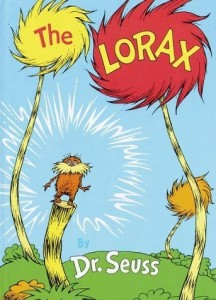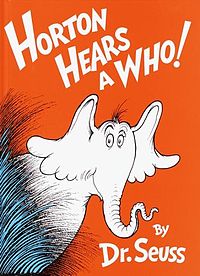As parents we all turn to Dr. Seuss to help our kids learn to read but there are other opportunities if we look a little deeper. Theodore Geisel (a.k.a. Dr. Seuss) was reluctant to begin a new book with the intent of teaching a moral because he said, “kids can see a moral coming a mile off” but at the same time he was not opposed to exploring issues that he felt strongly about. The following are stories that rank highly on the moral allegory scale and should give you and your kids the opportunity to discuss how the world works sometimes.

The Lorax (1971)
Lesson: Environmentalism and anti-consumerism.
This has always been my favorite Dr. Seuss book. I’ve always appreciated how the story shows as much as tells the moral and the artwork reflects the progressively darker vision of the world as the Once-ler destroys it in the interest of corporate greed. I will also take this opportunity to, once again, condemn the recent movie version as evil hypocritical consumerist green washing. You do not put the Lorax in a commercial selling SUVs.
“The Sneetches” (1961)
Lesson: Racial and ethnic equality.
This is another perfectly obvious allegory on par with the original Star Trek episode “Let That Be Your Last Battlefield” you know, the one where the two guys are half black and half white – but on different sides! The Sneetches are either star-bellied or plain and spend the story switching back and forth until no one knows who is which. It’s a ridiculously simple premise but one that you can talk to your kids about from a very young age. This one also works well as an early primer for bullying.
The Butter Battle Book (1984)
Lesson: The arms race.
You would think this one was written in the 1950s during the deepest depths of the Cold War rather than a few short years before the fall of the Soviet Union. With the Berlin Wall gone and the general threat of nuclear war between the US and Russia diminished you might think this story is irrelevant. However, it’s important to consider that the arms race is driven as much by the military-industrial complex that Eisenhower (remember the 1950s?) warned us about. With congressional arguments over cutting the deficit (but not the military) and controversy over government and police use of unmanned drones it seems this can be a good starting point for a conversation with your kids about how the world got in this crazy mess.
Yertle the Turtle (1958)
Lesson: Hitler and anti-authoritarianism.
I didn’t know this before but Geisel once said, “Yertle is Hitler.” Fortunately – or unfortunately as the case may be, the lesson doesn’t stop there. There is no shortage of despotic characters from recent history and even current news who can be put into Yertle’s allegorical framework. And again, the simple premise is the perfect starting point for a conversation with your kids that can easily tie back in with The Butter Battle Book and the Sneetches.
How the Grinch Stole Christmas (1957)
Lesson: The materialism and consumerism of the Christmas season.
Aside from obsessively watching the Chuck Jones cartoon version every year I really like this story because of Geisel’s approach to the moral. The Grinch attacks the Whos through his perception of their materialism, which ends up not only failing because of his misperception, but also makes him a better person once he realizes the truth. Beyond Geisel’s talent for whimsical art and rhyme this book shows his genius as a storyteller.

Horton Hears a Who! (1950)
Lesson: An allegory for the Hiroshima bombing and the American post-war occupation of Japan.
Wait, what?
I will be perfectly honest – I did not get that moral from this story until I was researching this post. I was aware of the message, “a person’s a person no matter how small” being co-opted by the right to life movement, which Geisel vigorously opposed, by the way. But I had to brush up on my post-war history to get at the roots of how this story was an allegory for the occupation of Japan. It’s interesting to note that during World War II the scrupulously fair-minded Geisel had a gigantic moral blind spot against Japanese Americans and supported internment. This obviously changed after Hiroshima and we can once again respect Geisel for not only admitting he was wrong but creating a story like this to argue the case for supporting the Japanese. There’s a lot here to talk about with your kids – and, as it turns out, more than I had originally anticipated.
Update: The Dr. Seuss library has been released in e-book format.